
Sweating Treatment Page Menu: 1 2 3 4 5 Next>>
Sweating Humoral Treatment in the Golden Age of Piracy, Page 2
Sweating Theory - Removing Humors
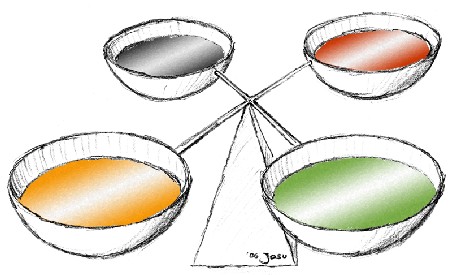
Artist: Jakob Suckale - Balancing the Four Humors
"All Humours are not profitably lessened and evacuated by sweat, but only some; not Blood not Choler [yellow bile], but all sorts of Flegm, and all Serum, as well the watry as the salt Muriatic [hydrochloride], the acid and sowr." (John Pechey, A Plain Introduction to the Art of Physick, 1697, p. 166)
Theories about what caused illness were still under development during the golden age of piracy, although nearly all of them were based in humor theory - the idea that the body contained a variety of humors or liquids which had to be properly balanced to create health in the body. The four bodily humors were generally recognized to be blood, black bile (melancholy), yellow bile (choler) and phlegm.
John Pechey explained that phlegm "may the more easily be driven forth by or with Sweat."1 This was generally agreed with by other physicians during the period. Ambroise Paré explained that the pox could be cured "by the excavation of a phlegmatick humor [phlegm], whether by the mouth and salivation, or by stool, urine, or sweat in men"2.
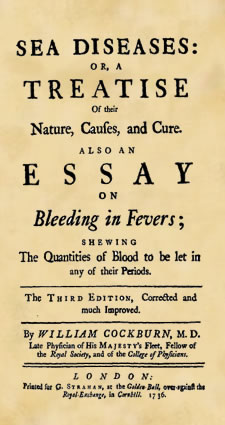
William Cockburn's Sea Diseases, 3rd ed.
Naval physician William Cockburn debated the benefits of bleeding, sweating and purging (referring to vomiting). He concluded that bleeding was always appropriate, but "because the secretion by the pores [sweating], is double of all the other secretions in the rest of the body; 'tis plain, where this secretion can be perform'd, that there may be a greater quantity separated from the blood... it may seem the most convenient and agreeable"3. He does warn that medicine is required to cause sweating which, by 'unlocking the spirits' of the blood (possibly referring here to phlegm, although he doesn't say that directly) "can only agree with those [patients] that are older, and have not so rich blood."4
This idea of breaking down the humors so that they could be sweated out is mentioned by several other physicians as well. Peachey noted that "glutinous Flegm, seeing it is not so fit for Motion, ought first, or at the same time, to be incided, attenuated, and made fluid"5 so that it could be sweated out.
Physician Thomas Sydenham is particularly concerned with the problem of making sure the humors are ready to be released via sweating, suggesting that this issue makes the use of sudorific and diaphoretic medicines useless in treating continuous fevers (those accompanying influenza and pneumonia). He advises that these unwanted elements should be "evacuated after the previous digestion [breaking down] of some Humour lodged in the Blood; in preparing of which Humour Nature has been a certain time busied, [so] that it might be ejected by Sweat"6. He further advises in cases where sweating was used in fevers accompanying small-pox or dysentery that "neither relieved the Sick; for it did not proceed from previous Concoction [combination, making it available to be sweated out], but from a confused motion of ill Particles"7.
Some physicians identified the type or part of humors they felt needed to be ready for removal. Pechey says that "acid sowr Humour ought also to be prepared for its Expulsion by Sweat."8 Physician Philip Woodman expands on this idea, explaining that when the body cannot be removed by perspiration they "Stagnate, and become Acid, Sharp, Saltish, &c. [etc.] ...which every one knows, is remedied by a Sweat, which opens up the Pores, rouses up this Acid Humour, and drives it out of the Body."8
The idea that such substances were acidic, sharp and sour are rooted in the ancient descriptions of taste. In his 1713 book Opthalmographia, Scottish physician Peter Kennedy explained that humors could 'turn sharp and acid' which could be revealed when the patient "being Bled, the Serous [serum-based] part proves very sharp to the Taste"9.
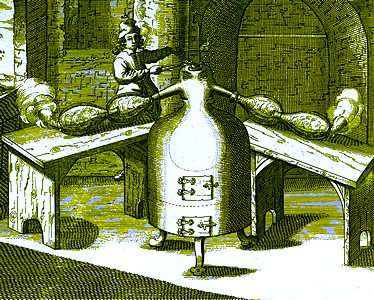
Distilling Liquids from Johann Glauber's Miraculi Mundi continuatio (1658)
The addition of a 'saltish' quality appears to have arisen from research by Dutch pharmacist and alchemist Johann Rudolph Glauber. Glauber experimented with acidic and alkali chemicals, noting that "when the two are brought together…and the one part has overcome and killed the other, neither liquor [liquid] ...can be found in their dead bodies, but the same has been made, as both were before and from which they were derived, namely ordinary saltpeter"10.
As a result, the four terms - acid, sharp, sour and salt - are used somewhat interchangeably to describe altered, unwanted humors in medical books throughout this period. For example, apothecary John Quincy explains in his medical dictionary that acid spirits "are so called ...because they are specifically heavier than Water, and are nothing else but sharp Salts divided and fused in Phlegm."11
Joannes Sintelaer says that venereal disease is the result of a
fix’d Acid Ferment being convey’d into the Mass of the Blood, and its Juices, [which] less or more congeals its Humours, and introduces that Distemper we call the Pox. According to this Supposition, the Remedies that ought to be made use of for the Cure of this Disease must be such, as by their Alcalious [alkaline] and Sulphureous, as well as Volatil Particles have a Power, not only to Check and Correct the Acid Ferment, but also to restore by their Volatility the true Motion of the Blood, by attenuating the Coagulated Humours, and Expel them thro’ the Pores, or by Urine."12
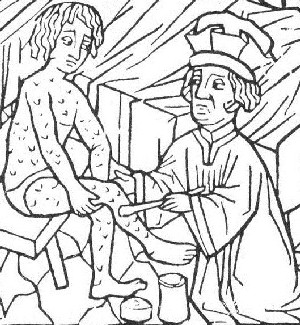
Medicating the Pox in Venice, Bartholomaus Steber (1498)
Here Sintelaer suggests that acid humors were counteracted by alkaline medicines, ejecting them either through sweating ('thro' the Pores') or by purging via the urine. Sintelaer later expands on this, suggesting that the blood of a patient suffering from a long-standing pox had to be purified and cleansed of 'the Pocky Ferment' "chiefly by Sweating, to Expell the poisonous Humour thro’ the Pores of the Body, which, can't be so conveniently, nor so safely attain'd to by Purgatives nor Vomitives"13.
While he is opposed to 'purging upwards' using emetic, vomit-inducing medicines, he is not entirely opposed to purging downwards. He explains that the pox "Congeals the Humours of our Bodies; the grosser part of which may be conveniently evacuated by Stool, provided it be done with due Circumspection [prudence], so as not to impair too much the Strength of your Patient, so as to render him incapable of undergoing the Fatigue of so long and often repeated Sweats, as are absolutely necessary to expell the Venereal Poison thro’ the Pores of the Body."14
According to physician Robert James, one of the roles of diaphoretic medicines was to modify this acidic humor. He explains that diaphoretics "act in a privative Manner, by absorbing and changing the Acid in the Primæ Viæ [bowels], which carried into the Blood depresses its Spirituosity, Fluidity and intestine Motion"15.
1 John Pechey, A Plain Introduction to the Art of Physick, 1697, p. 166; 2 Ambroise Paré, The Workes of that Famous Chirurgion Ambrose Parey, 1649, p. 466; 3 William Cockburn, An Account of The Nature, Causes, Symptoms and Cure of the Distempers That are incident to Seafaring People, 1696, p. 95; 5 Thomas Sydenham, The Whole Works of Dr. Thomas Sydenham, 3rd ed, 1701, p. 108; 6 Sydenham, p. 184; 7 Pechey, p. 466; 8 Philip Woodman, Medicus Novissimus; or, The Modern Physician, 1712, p. 49; 9 Peter Kennedy, Opthalmographia, Or, A Treatise of the Eye, 1713, p. 46; 10 Johann Rudolph Glauber, quoted in Joe Peatrowsky, The Origins of Acids and Alkalis, gathered 4/10/16; 10 John Quincy, Lexicon Physico-Medicum, 1726, p. 7; 12 Joannes Sintelaer, The Scourge of Venus and Mercury, 2nd ed,, 1709, p. 233; 13 Sintelaer, p. 245; 14 Sintelaer, p. 246; 15 Robert James, Pharmacopœia universalis, 1747. p. 165
Sweating Theory - Removing Disease-Causing Elements of Humors
Related to the notion of driving acidic humors out of the body via sweat was that of driving 'poisons' or the cause of diseases out the same way. Physician Joannes Sintelaer gives a graphic description of ejecting the portion of the humor causing the pox, stating it is "highly necessary to expel that mortal Enemy of our Constitution out of his lurking Holes" using sweating.1 Two reasons why sweating could (and couldn't) remove disease-causing elements embedded in humors are suggested by period physicians.
The first concerns the size of the particles. Physician Robert James explains that "as the Evacuation of
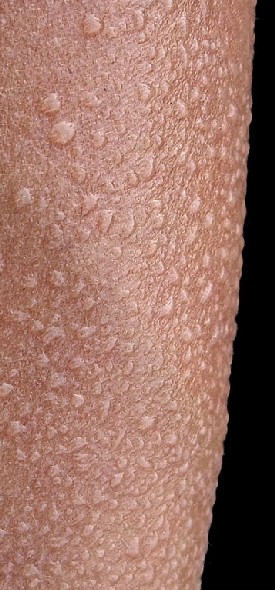
Photo: wiki user Minghong
the finer Parts of the morbific [disease-causing] Matter, thro' the Pores of the Skin, by insensible Transpiration, is of all others the most healthful, and as the Obstruction therof is the Occasion of many Maladies, so the Use of Diaphoretics, which promote this cutaneous Excretion [sweating], is certainly very great, universal, and almost infallible, in almost all Diseases"2.
The fineness or 'subtlety' of disease-causing humors is critical to the effectiveness of sweating according to Sydenham. He contrasts plague-caused fevers with other fevers "where the astimulating Particles are not so subtle [fine], and are incorporated with grosser [less refined] Humours, [so that] the malignant Minera [mineral] can not only not be carried off by Sweat, but is very often encreased by those sudorifick Medicines"5. So the poisonous elements of coarser humors cannot be sweated out, being instead left behind in a more concentrated form and intensifying the fever.
The second explanation of how disease-causing elements in humors can be removed via sweating concerns how deeply buried they are in the humors. Physician John Peachey suggests that the poisonous elements can be "deeply rooted in the Blood and Humours" for patients suffering from the pox and similar chronic diseases.6 Such embedded humors require "very intense and frequent sweating, daily for a long time ...not only [so] that the Impurities and Corruptions of the Viscera [internal organs] and Humours may be carried off, but also, that the morbific [disease-causing] Tinctures that are deeply imprinted thereupon, may be wholly destroyed"7.
1 Joannes Sintelaer, The Scourge of Venus and Mercury, 2nd ed,, 1709, p. 230; 2 Robert James, Pharmacopœia universalis, 1747. p. 166; 3 Thomas Sydenham, The Whole Works of Dr. Thomas Sydenham, 3rd ed, 1701, p. 179; 4 Sydenham, p. 159; 5 Sydenham, p. 179; 6,7 John Pechey, A Plain Introduction to the Art of Physick, 1697, p. 165
Sweating Theory - Curing Conditions Created by Cold
Physician Robert James advises that, "sweating is very serviceable in those Distempers which proceed
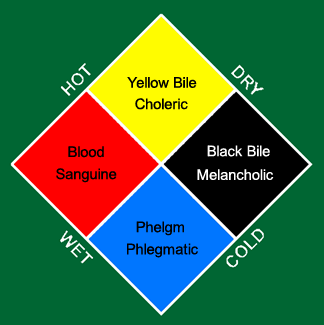
Medicating the Pox in Venice, Bartholomaus Steber (1498)
from an external Cold, and obstructed Perspirations, as in Catarrhs [mucus build up in the nose or throat], Rheumatisms, Fluxes [Diarrheas], Stoppages of the head, Coughs, and glandular Tumors... [and in] all those Diseases which are called Cold, as in Dropsies of every Kind, the cold Scurvy, Pox, settled Gout, Sciatica, Palsy, and those of the same Nature"1.
While the basic idea that sweating removed 'cold problems' sounds rather simplistic, it is based in humor theory. The different humors were thought to have intrinsic hot, cold, wet and dry properties. Plant-based medicines were also thought to have these properties in varying degrees so that an illness with a particular humoral property was thought to be treatable with a medicine based in the opposing property.
People were also assigned four qualities, referred to as temperaments, which roughly corresponded to the four bodily humors. These are shown in the four diamonds below the names of the four bodily humors in the chart at right and in a more graphic form shown attached to different types of people
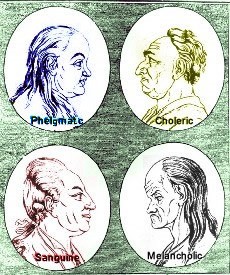
Four Humors as Temperaments, From
Physiognomische Fagmente, by J.C. Lavaters
at left. So it should not be surprising that those with temperaments considered 'cold' (melancholy and phlegmatic) would benefit from sweating, as physician John Pechey suggests. He notes that sweating medicines (generally considered 'hot') were appropriate "for such as are endued with a cold Temperament"2.
Physician Gideon Harvey gave this fairly straightforward idea of sweating beating cold humors a more intricate spin when discussing the treatment of fevers. He explained that when people came in contact with cold air, which "is commonly termed, taking of Cold, for want of sufficient Cloathing", they were actually "receiving of crude saline [salt] Particles from without"3. This could result in 'a Diary, or Ephemera' (a fever lasting less than 24 hours) or even a putrid fever (such as accompanied typhus or bubonic plague). However, "upon taking immediately ...some potent Diaphoretic [sweat-inducing medicine], with the Assistance of a Load of Bed-cloathes they have soon fallen into a Sweat which concluded hath wholly carried off the Fever, by expelling the said saline Particles, that did violently agitate the Animal Spirits."4
You may notice that the basic idea behind his explanation is that 'salt' is being introduced into the body (and thus corrupting the humors of the body by making them 'saltish'). This brings the discussion of theory back to the idea that humors can be corrupted and made salty (or acidic), which could be removed by sweating.
1 Robert James, Pharmacopœia universalis, 1747. p. 164-5; 2 John Pechey, A Plain Introduction to the Art of Physick, 1697, p. 164; 3 Gideon Harvey, The Vanities of Philosophy and Physic, 2nd ed, 1700, p. 70; 4 Harvey, p. 70-1

